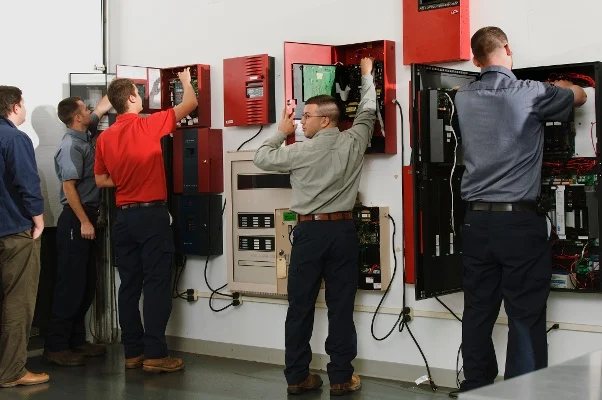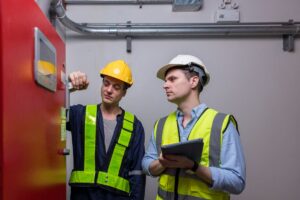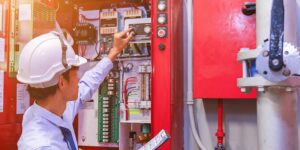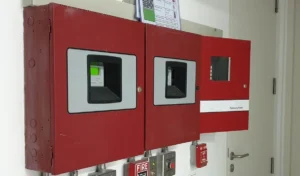A fire alarm system is an important part of a complete fire protection plan because it monitors the health of all fire protection equipment in a building. Most people are familiar with smoke detectors and fire alarms that go off when a fire breaks out, but few know how important it is to have a system that constantly monitors the health and safety of fire protection equipment. A fire alarm system does not detect fire directly, but it monitors equipment such as water tanks, sprinkler valves, and fire pumps to ensure that they are functioning properly. These systems are essential to the safety of a building because they help prevent fire protection systems from failing before a real emergency occurs.
The Difference Between a Fire Alarm System and a Fire Alarm
It is important to understand the difference between a regular fire alarm system and a fire detection system. Although they are both part of an overall fire protection structure, they work differently. When a fire alarm detects an immediate danger, such as smoke or high temperatures, it sounds an alarm so that everyone can evacuate the building. A fire alarm system, on the other hand, ensures that the water is flowing properly, the sprinkler valves are open, and the fire pumps are functioning properly. The control system will sound an alarm if any part of the fire suppression system fails or suddenly changes condition. This usually happens before a fire breaks out. Because these tools can help immediately, they are preventative rather than reactive.
Components Often Monitored by Fire Alarm Systems
Many parts of a complete fire alarm system need to be monitored. Control valves are very important because they need to be kept open so that water can flow to the fire pumps. Even if someone accidentally closes a valve, it can cause the system to stop working when it is needed most. The monitoring system can detect this and send an alert. It also monitors the fire pumps to ensure that they are full of water and ready to go. In addition, the water storage tanks and pressure levels are monitored to ensure that there is enough water and the pressure is appropriate. Changes outside the permitted water volume are reported immediately so that people in the building can evacuate quickly.
The Role They Play in Ensuring Safety Codes and Regulations
Many building codes and fire safety regulations require the installation of fire alarm systems. This is especially true for commercial, industrial, and multi-residential buildings. Organizations such as the National Fire Protection Association (NFPA) cite the need for fire alarm systems in their guidelines, specifically NFPA 72 and NFPA 13. Compliance with these regulations is not only to avoid fines or penalties, but also to ensure the safety of the public and those living or working in the building. Building owners are responsible for ensuring that fire alarm systems are always functioning properly. Without a fire alarm system, they may not know when a critical component is failing, exposing people in the building to danger, and they are subject to additional liability if a problem occurs.
Why is it a good idea to install a fire alarm system?
The peace of mind that comes with installing a fire alarm system is the most significant benefit. It acts as a silent guardian, always monitoring an important fire alarm system. Problems, whether technical, electrical or caused by human error, can be detected and resolved immediately via a 24/7 real-time alarm and tracking system. This significantly reduces the risk of fire and also ensures that maintenance teams, building managers or emergency services can arrive on site more quickly. Insurance companies can also reduce premiums for buildings equipped with good monitoring systems, as the risk of fire is significantly reduced.
Applications in different types of buildings
When it comes to fire safety, every building is different. Monitoring systems are very important in high-rise buildings, so that water valves and fire pumps on different floors can be monitored. These systems can monitor large sprinkler networks to ensure that the water supply is not interrupted in places such as shops or factories where goods or machinery are stored, which are more susceptible to fire. Fire monitoring systems ensure that every part of the fire suppression system is always ready, even in busy places such as schools, hospitals and shopping centres where rapid escape is difficult. Monitoring systems make buildings safer and more reliable, regardless of their size or purpose.
Integrate modern building management systems
Today, building management systems (BMS) are increasingly in the cloud. This connected approach not only makes everything run more smoothly, it also helps people make smarter decisions in a variety of situations. Remote testing and predictive maintenance are now possible, which can help prevent problems before they lead to equipment failure or pose a safety risk.
Testing and monitoring monitoring systems
Fire alarm systems require regular testing and maintenance, just like the systems they monitor. Follow a maintenance schedule to test devices like tamper switches, pressure monitoring systems, and alarm connections. In many locations, qualified fire safety personnel are required to perform inspections every three months or annually. These tests ensure that all connections and communication links remain in good condition and that alarms are functioning properly. Battery-powered monitoring components also require regular battery charge checks to ensure that they do not fail in the event of a power failure. A well-maintained system ensures that problems are detected and reported promptly when they occur.
Long-Term Costs and Savings to Consider
Installing a fire alarm system requires an initial investment, but the savings often outweigh the long-term costs. These systems help protect valuable assets and reduce downtime by preventing system failures and reducing the risk of serious fire damage. Not violating regulations or failing inspections can also save money and keep operations running smoothly. Plus, it’s often easier and less expensive to detect problems early than to wait until they become serious problems. This proactive safety approach benefits both the bottom line and the morale of building owners and managers.
Conclusion
Fire suppression systems are an essential part of safe and compliant buildings, not just an add-on to fire protection systems. By continuously monitoring fire protection equipment such as pumps, valves, and water sources, these systems ensure that everything is working properly before a real problem occurs. There are many benefits to installing a fire suppression system, including meeting regulatory requirements, sending real-time reports, and reducing insurance costs. These devices are an important safety net that every modern building should have, as the risk of fire cannot be completely eliminated. Investing in a fire suppression system now will lead to better, safer and more sustainable fire protection in the future.




